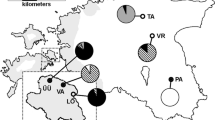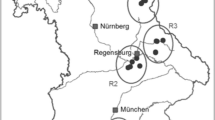Abstract
Exposed cliffs in the Northern Swiss Jura mountains harbour a highly diverse flora with numerous rare and relict plant species. The genetic structure of cliff populations is of particular interest because in a variety of plant species the populations are small, isolated and separated from their main distribution area in the Alps and the Mediterranean. We examined possible relationships between population size and size structure, sexual reproduction and genetic diversity of Alyssum montanum, a relict plant species occurring on limestone cliffs in the Northern Swiss Jura mountains. The population size of A. montanum ranged from 8 to 248 plant individuals on the 12 cliffs examined. Most populations contained a high proportion of small-sized (=young) plants indicating a successful establishment of seedlings. Fitness-related traits of A. montanum (percentage of reproductive individuals, number of fruits, fruit weight) varied widely between cliffs and were neither related to the size of the populations nor to the percentage of vegetation cover on the cliffs. RAPD-PCR analysis revealed that A. montanum populations exhibit a remarkably high genetic diversity. However, genetic diversity decreased with decreasing population size. Moreover, the positive relationship found between genetic variability and fitness-related traits indicates that population size is a key factor for the persistence of A. montanum on limestone cliffs.





Similar content being viewed by others
References
Avise J, Hamrick JL (1996) Conservation genetics: case histories from nature. Chapman & Hall, New York
Bauert MR, Kälin M, Edwards PJ, Baltisberger M (2007) Genetic structure and phylogeography of alpine relict populations of Ranunculus pygmaeus and Saxifraga cernua. Bot Helv 117:181–196
Baur B (ed) (2003) Freizeitaktivitäten im Baselbieter Wald. Ökologische Auswirkungen und ökonomische Folgen. Verlag des Kantons Basel-Landschaft, Liestal
Britten HB (1996) Meta-analyses of the association between multilocus heterozygosity and fitness. Evolution 50:2158–2164
Brys R, Jaquemyn H, Edels P (2004) Reduced reproductive success in small populations of the self-incompatible Primula vulgaris. J Ecol 92:5–14
Council Directive 92/43/EEC (http://ec.europa.eu/environment/nature/legislation/habitatsdirective/index_en.html)
Dannemann A (2000) Der Einfluss von Fragmentierung und Populationsgrösse auf die genetische Variation und Fitness von seltenen Pflanzenarten am Beispiel von Biscutella laevigata (Brassicaceae). Dissertationes Botanicae, Band 330
Dostálek T, Münzbergová Z, Placková I (2010) Genetic diversity and its effect on fitness in an endangered plant species, Dracocephalum austriacum L. Conserv Genet 11:773–783
Doyle JJ, Doyle JL (1990) A rapid total DNA preparation procedure for fresh plant tissues. Focus 12:13–15
Dubreuil M, Riba M, Mayol M (2008) Genetic structure and diversity in Ramonda myconi (Gesneriaceae): effects of historical climate change on a preglacial relict species. Am J Bot 95:577–587
Eckstein RL, Danihelka J, Otte A (2009) Variation in life-cycle between three rare and endangered floodplain violets in two regions: implication for population viability and conservation. Biologica 64:69–80
Ellstrand NC (1992) Gene flow by pollen: implications for plant conservation genetics. Oikos 63:77–86
Fischer M, Matthies D (1998) RAPD variation in relation to population size and plant fitness in the rare plant Gentianella germanica (Gentianaceae). Am J Bot 84:1685–1692
Gabrielsen TM, Bachmann K, Jakobsen KS, Brochmann C (1997) Glacial survival does not matter: RAPD phylogeography of Nordic Saxifraga oppositifolia. Mol Ecol 6:831–842
Garzia-Gonzàles R, Carrasco B, Penailillo P, Letelier L, Herrera R, Lavandero B, Moya M, Caligaria PDS (2008) Genetic variability and structure of Gomortega keule (Molina) Baillon (Gomortegaceae) relict populations: geographical and genetic fragmentation and its implications for conservation. Botany 86:1299–1310
Hardy OJ, Maggia L, Bandou E, Bryne H, Caron H, Chevallier MH, Doligez A, Dutech C, Kremer A, Latouch-Hallé C, Troispoux V, Veron V, Degen B (2006) Fine-scale genetic structure and gene dispersal interference in 10 Neotropical tree species. Mol Ecol 15:559–571
Hegi G (1986) Illustrierte Flora von Mitteleuropa. Lehmann’s Verlag, Munich
Hegland SJ, Van Leeuwen M, Oostermeijer JGB (2001) Population structure of Salvia pratensis in relation to vegetation and management of Dutch dry floodplain grasslands. J Appl Ecol 38:1277–1289
Hensen I, Oberprieler C, Wesche K (2005) Genetic structure, population size and seed production of Pulsatilla vulgaris Mill. (Ranunculaceae) in Central Germany. Flora 200:3–14
Huff DR, Peakall R, Smouse P (1993) RAPD variation within and among natural populations of outcrossing Buffalograss Buchloë dactyloides (Nutt.) Englm. Theor Appl Genet 86:927–934
Knecht D (1999) Felsinventar Basler Jura und Schutzkonzept. Unpublished report
Kothera L, Richards CM (2007) Genetic diversity and structure in the rare Colorado endemic plant Physaria bellii Mulligan (Brassicaceae). Conserv Genet 8:1043–1050
Le Corre V, Dumoulin-Lapegue S, Kremer A (1997) Genetic variation at allozyme and RAPD loci in sessile oak Quercus petraea (Matt.) Liebl.: the role of history and geography. Mol Ecol 6:519–529
Leimu R, Mutikanen P, Koricheva J, Fischer M (2006) How general are positive relationships between plant population size, fitness and genetic variation? J Ecol 94:942–952
Luijten SH, Dierick A, Gerard ADJ, Oostermeijer JGB, Raijmann LEL, Den Nijs HCM (2000) Population size, genetic variation, and reproductive success in a rapidly declining, self-incompatible perennial (Arnica montana) in the Netherlands. Conserv Biol 14:1776–1787
Lutz E, Schneller JJ, Holderegger R (2000) Understanding population history for conservation purposes: population genetics of Saxifraga aizoides (Saxifragaceae) in the lowlands and lower mountains north of the Alps. Am J Bot 87:583–590
Luzuriaga AL, Escudero A, Albert MJ, Giménez-Beanivides L (2006) Population structure effect on reproduction of a rare plant: beyond population size effect. Can J Bot 84:1371–1379
McMillan MA, Larson DW (2002) Effects of rock climbing on the vegetation of the Niagara escarpment in southern Ontario, Canada. Conserv Biol 16:389–398
Meirmans PG, Van Tienderen PH (2004) GENOTYPE and GENODIVE: two programs for analysis of genetic diversity of asexual organisms. Mol Ecol Notes 4:792–794
Moser DM, Gygax A, Bäumler B, Wyler N, Palese R (2002) Rote Liste der gefährdeten Arten der Schweiz. Farn und Blütenpflanzen, Bundesamt für Umwelt, Wald und Landschaft, Bern
Müller SW (2006) Human impact on the vegetation of limestone cliffs in the northern Swiss Jura mountains. University of Basel, Basel
Müller SW, Rusterholz HP, Baur B (2004) Rock climbing alters the vegetation of limestone cliffs in the northern Swiss Jura Mountains. Can J Bot 82:862–870
Müller SW, Rusterholz HP, Baur B (2006) Effects of forestry practices on relict plant species on limestone cliffs in the northern Swiss Jura mountains. Forest Ecol Manage 237:227–236
Müller-Dombois D, Ellenberg H (2002) Aims and methods of vegetation ecology. Wiley, New York
Neis M (1978) Estimation of average heterozygosity and genetic distance from a small number of individuals. Genetics 89:583–590
Nybom H, Bartish IV (2000) Effects of life history traits and sampling strategies on genetic diversity estimates obtained with RAPD markers in plants. Perspect Plant Ecol Evol Syst 3:93–114
Oostermeijer JGB, Veer RV, den Nijs JCM (1994) Population structure of the rare, long-lived perennial Gentiana pneumonanthe in relation to vegetation and management in the Netherlands. J Appl Ecol 31:428–438
Peakall R, Smouse PE (2006) GENEALEX 6: genetic analysis in Excel. Population genetic software for teaching and research. Mol Ecol Notes 6:288–295
Pérez-Collazos E, Catalan P (2007) Genetic diversity analysis and conservation for the Iberian threatened populations of the irano-turanian relict Krascheninnikovia ceratoides (Chenopodiaceae). Bot J Linn Soc 92:419–429
Peterson A, Bartish IV, Peterson J (2008) Effects of population size on genetic diversity, fitness and pollinator community composition in fragmented populations of Anthericum liliago L. Plant Ecol 198:101–110
R Development Core Team (2011) R: A language and environment for statistical computing. R Foundation for Statistical Computing, Vienna
Reisch C, Poschlod P, Wingender R (2003) Genetic variation of Saxifraga paniculata Mill. (Saxifragaceae): molecular evidence for glacial relict endemism in Central Europe. Biol J Linn Soc 80:11–21
Rusterholz HP, Müller SW, Baur B (2004) Effects of rock climbing on plant communities on exposed limestone cliffs in the Swiss Jura mountains. Appl Veg Sci 7:35–40
Rusterholz HP, Verhoustraeten C, Baur B (2011) Effects of long-term trampling on the above-ground forest vegetation and soil seed bank at the base of limestone cliffs. Environ Manage 48:1024–1032
Schmidt K, Jensen K (2000) Genetic structure and AFLP variation of remnant populations in the rare plant Pedicularis palustris (Scrophulariaceae) and its relation to population size and reproductive components. Am J Bot 87:678–689
Smidová A, Münzbergová Z, Placková I (2011) Genetic diversity of a relict plant species, Ligularia sibirica (L.) Cass. (Asteraceae). Flora 206:151–157
Soulé ME (1986) Viable populations for conservation. Cambridge University Press, Cambridge
Španiel S, Marhold K, Filová B, Zozomova-Lihová J (2011) Genetic and morphological variation in the diploid–polyploid Alyssum montanum in Central Europe: taxonomic and evolutionary considerations. Plant Syst Evol 294:1–25
Španiel S, Marhold K, Filová B, Zozomova-Lihová J (2012) A new circumscription of Alyssum montanum ssp. montanum and A. montanum ssp. gmelinii (Brassicacea) in Central Europe: molecular and morphological evidence. Bot J Linn Soc 169:378–402. doi:10.1111/j.1095-8339.2012.01225.x
Vogel JC, Rumsey FJ, Russel SJ (1999) Genetic structure, reproductive biology and ecology of isolated populations of Asplenium csikii (Aspleniaceae, Pteridophyta). Heredity 83:604–612
Vogler F, Reisch C (2011) Genetic variation on the rocks—the impact of climbing on the population ecology of a typical cliff plant. J Appl Ecol 48:899–905
Walter H, Straka H (1970) Arealkunde. Floristisch-historische Geobotanik. Eugen Ulmer, Stuttgart
Wassmer A (1998) Zur Felsenflora des östlichen Kettenjuras. Grundlagen und Berichte zum Naturschutz. Band 17. Baudepartement, Sektion Natur und Landschaft, Aargau
Wezel A (2007) Changes between 1927 and 2004 and effect of rock climbing on occurrence of Saxifraga paniculata and Draba aizoides, two glacial relicts on the limestone cliffs of the Swabian Jura, southern Germany. J Nat Conserv 15:84–93
Yeh F, Yang R, Boyle T (1997) Popgene Version 1.31. Microsoft Window-based freeware for population genetic analysis, Alberta
Young EW, Clarke GM (2001) Genetics, demography and viability of fragmented populations. Cambrige University Press, Cambridge
Zoller H (1989) Die Verarmung der Pflanzenwelt. In: Imbeck-Löffler P (ed) Natur aktuell, Lagebericht zur Situation der Natur im Kanton Basel-Landschaft im Jahr 1988. Verlag des Kantons Basel-Landschaft, Liestal, pp 217–246
Acknowledgments
We thank A. Baur and three anonymous reviewers for their valuable comments on the manuscript.
Author information
Authors and Affiliations
Corresponding author
Electronic supplementary material
Below is the link to the electronic supplementary material.
Rights and permissions
About this article
Cite this article
Rusterholz, HP., Aydin, D. & Baur, B. Population structure and genetic diversity of relict populations of Alyssum montanum on limestone cliffs in the Northern Swiss Jura mountains. Alp Botany 122, 109–117 (2012). https://doi.org/10.1007/s00035-012-0105-0
Received:
Accepted:
Published:
Issue Date:
DOI: https://doi.org/10.1007/s00035-012-0105-0




